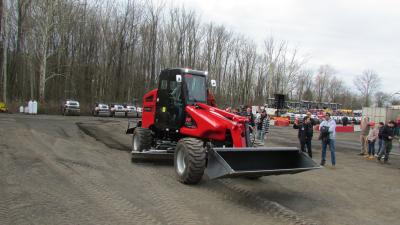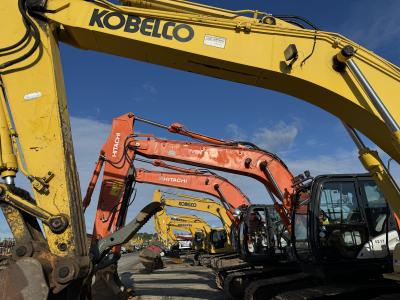Before the Charlotte (NC) Area Transit Systems could begin construction on a $399- million light rail corridor, existing utility lines in the train’s path had to be moved and new utility lines had to be installed.
D.C. Directional Inc., based in Rock Hill, SC, was one of the utility contractors involved in readying the infrastructure for construction of the major transportation project. Construction has already begun on the first leg of Charlotte’s light rail system, a 10-mi. stretch between downtown Charlotte and suburban Pineville named the South Corridor. Diesel-powered trains will run along the system, which will have lines running from downtown to five different points on the perimeter of the city’s sprawling suburbs.
As a subcontractor, D.C. Directional worked from October to November on behalf of the prime contractor commissioned by Qwest to replace its old lines by installing 16,000 ft. (4,877 m) of new telecommunication lines along the railroad track’s right of way. And for Danny Stover, owner of D.C. Directional, working with telephone lines is something to which he is more than accustomed.
Stover spent more than a decade performing cable splicing for telephone companies before starting his horizontal directional drilling (HDD) business nearly eight years ago. While his primary market is installing communication lines for telephone and cable companies, he also installs other utilities, including gas, water and electric.
Since entering the HDD market, Stover has been making a name for his company. In addition to being selected for the North Carolina light rail system project, D.C. Directional is slated to install 9-mi. job in Calhoun Falls, SC.
“I think they pick us because we’re dependable, and we’re good at what we do,” Stover said. “When we say we’re going to get something done, we get it done.”
Working on the Train
For the light rail corridor, D.C. Directional had to complete approximately 16,000 ft. (4,877 m) of boring along the rail’s right of way. Stover’s crews were to install two 2-in. (6.4 cm) plastic pipes containing Qwest telecommunication lines parallel to the railroad tracks. A feat by itself, the job proved even more challenging because of its location in the city’s congested downtown area. Not only did motorist and pedestrian traffic make working conditions difficult, but Stover and his six employees also had to bore around the numerous pipes of existing utilities that snaked their way underneath the right of way.
“There were a lot of other utilities that had been bored in across the railroad tracks and that created a lot of problems,” Stover said. “A lot of the right of way was also overgrown with trees, shrubs and other weeds.”
In tackling the job, Stover used his new Vermeer D36x50 Navigator HDD unit, a Caterpillar 413B loader backhoe and a Lely vacuum system. Stover purchased the D36x50 approximately five months ago because he wanted a larger HDD machine with more power. The two previous HDD machines he owned — a D16x20A and a D24x40A — were smaller units.
The D36x50, with 10-ft. (3 m) and 15-ft (4.6 m) rack option, provides optimal power in a compact package. The machine, which has a maximum torque of 4,900 ft./lb, a pullback of 36,000 lbs. (16,300 kg), and mudflow of 50 gpm, was built to perform a wide range of medium-diameter, mid-to-long-distance utility installations.
Overcoming Obstacles
Stover started out using a 4.5-in. (11.4 cm) duckbill drill head in order to complete a 1,000-ft. (305 m) bore. But as his workers began locating the drill head to ensure it didn’t hit any of the existing underground utilities, the congestion in downtown Charlotte posed problems once again.
“We were getting bad interference when trying to locate with our own machine, and then we had to use the Vermeer Eclipse locator,” he said. “It was able to give us a lot clearer reading.”
The Vermeer Eclipse is a target-in-the-box locating system that uses the most optimal, interference-free operating frequency. It’s the first system of its kind to display drill head location and locate points in a real-time, bird’s-eye view. A 3-D antenna configuration enables the unit to see locate points and the transmitter’s position, allowing the operator to walk directly to the drill head. Its receiver also provides 3-D left/right and up/down remote steering information.
Once the drill head was located, Stover and his crews continued the 1,000-ft. bore. In some areas, Stover said his crews had to bore 18 ft. (5.5 m) deep in order to avoid the route of future underground construction planned by the city. And as they bore deeper, they ran into hard sandstone in some areas, which required them to change from the duckbill drill head to a TriHawk drill head with sharper teeth to penetrate the hard ground.
Stover said he used a polymer and bentonite drilling-fluid mixture so that the “rod wouldn’t start tightening up and locking down.”
The D36x50 features electronic displacement controls for thrust and rotation. The precise fingertip controls contain switches for operating the on-board drilling fluid pump, breakout system and throttle operations. With the combination of the drilling fluids and TriHawk drill head, Stover’s crews made it out of the bore successfully.
After drilling a pilot bore, Stover used an 8-in. (20 cm) Vermeer fluted backreamer to pull through the plastic pipe. Stover said no pre-reams were necessary.
“From the time we started drilling and pulling back the pipe, it took us about six hours. The D36x50 has a lot more rotation power for its size,” Stover said. “For a 10-foot machine, it’s probably the strongest in the industry.”
For many contractors, success is measured by whether they completed the job on schedule. And it’s even better when you can complete a job ahead of schedule. Such was the case for D.C. Directional, which finished installing the telecommunication lines two months before deadline. Stover’s crew worked 10 hours a day for three weeks on the project, receiving help for approximately a week from four members of Greene’s Directional.
“Everybody was really pleased with our progress, especially when the 1,000-foot bore was completed,” Stover said. “After seven and a half years, you pretty much figure out what works and what doesn’t.”
Tara Deering is a technical writer of Two Rivers Marketing in Des Moines, IA.
(This story also can be found on Construction Equipment Guide’s Web site at www.cegltd.com.) CEG
Today's top stories















